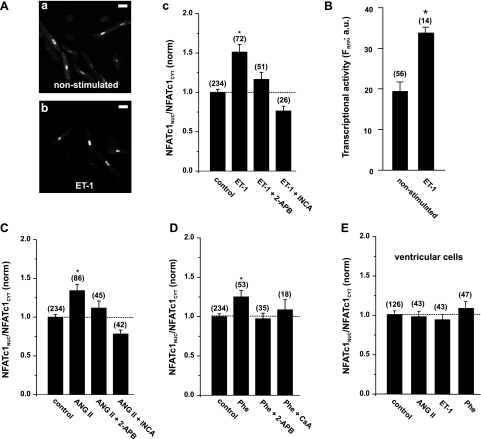Fig. 2.
Neurohumoral agonists induce nuclear accumulation and transcriptional activity of NFATc1 in atrial (A–D) and ventricular (E) cells. Overnight stimulation with 100 nM endothelin-1 (ET-1) resulted in an increase in nuclear-localized NFATc1 (A,b compared with nonstimulated cells in A,a) by 50% [ratio of nuclear NFAT to cytoplasmic NFAT (NFATNuc/NFATCyt); A,c]. This effect was prevented by the inositol 1,4,5-trisphosphate (IP3) receptor blocker 2-aminoethoxydiphenyl borate (2-APB; 2 μM) and was sensitive to the calcineurin (CaN) inhibitor of NFAT-CaN association-6 (INCA-6; 1 μM). B: In atrial myocytes expressing NFATc1-GFP, stimulation with ET-1 resulted in higher transcriptional activity, measured with NFAT-sensitive expression of the red fluorescent protein (RFP) (NFAT-RFP reporter; see text for details). FRFP, fluorescence of RFP [in arbitrary units (AU)]. C and D: increases in nuclear localization of NFATc1 were also induced by ANG II (2 μM) and phenylephrine (Phe; 10 μM) and were prevented by 2-APB and CaN inhibition. CsA, cyclosporin A. E: all agonists failed to induce activation of NFATc1 in ventricular cells. Numbers in parentheses indicate the number of individual cells tested. NFATNuc/NFATCyt ratios are normalized (norm) to control. *P < 0.05, significantly different from control. Scale bar = 30 μm.

